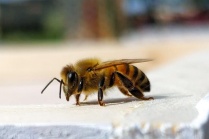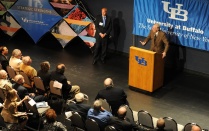Hoekstra's bees are happy

If you’re looking for some good news, here’s a tiny something to “bee” happy about. The UB Bees program, which launched last summer, reports that all six of its honeybee colonies survived their very first winter. This sweet success is meaningful because nationally, hives have been perishing at rates of about 30% over winter in recent years, says David Hoekstra, clinical assistant professor of biological sciences, who runs the UB Bees research and outreach initiative. Story by Charlotte Hsu.
Campus News
Good vibrations! UB honeybees survive their first winter
Photos: Meredith Forrest Kulwicki
By CHARLOTTE HSU
Published May 28, 2020 This content is archived.
If you’re looking for some good news, here’s a tiny something to “bee” happy about.
The UB Bees program, which launched last summer, reports that all six of its honeybee colonies survived their very first winter.
This sweet success is meaningful because nationally, hives have been perishing at rates of about 30% over winter in recent years, says David Hoekstra, clinical assistant professor of biological sciences, who runs the UB Bees research and outreach initiative.
“Hives die off for various reasons, from diseases, mites, starvation, pesticides, the cold and other causes,” he says. “Many beekeepers experience 50% or greater seasonal die off, so I was ecstatic that all six of the hives are still standing and buzzing away and happy and healthy this spring. We easily could have lost all of them, but amazingly they all survived.”
Buzz off, drones! How bees survive the winter
The UB bees live atop a grassy knoll between Crofts Hall and Bizer Creek on the North Campus, where each colony has its own bee tower.
As humans practice social distancing, honeybees survive the winter by doing the opposite: Members of each hive crowd together, forming what scientists call a “thermoregulating cluster” that helps the insects stay warm.
“They form a tight ball in the middle of the hive, and by doing so they can move around the hive eating their honey, and generate enough heat to survive the winter,” Hoekstra says. “The only time they will break from this cluster is to go outside and go to the bathroom. Bees are fastidious cleaners and will not go inside the hive, so they have to hold it for weeks or months until its warm enough to venture out to relieve themselves.”
But that’s only part of the epic and somewhat ghastly story of how honeybees persevere through colder months.
In fall, female worker bees banish male drones, sometimes literally pulling them out of the hive and leaving them outside to die. Male bees serve no purpose to the colony during winter (they cannot defend or forage for food), so exiling them reduces demand for food at a time when nectar and pollen are scarce and colonies must tap stores of honey to survive, Hoekstra says.
Hoekstra and UB Bees co-founder Alex Dombrowski, a biological sciences graduate, worked with other student volunteers to help the bees survive winter. The beekeepers wrapped the hives in insulation; reduced the size of the entrance hole to limit cold air blowing in; added pine shavings to the roof to provide insulation and moisture control; fed the bees sugar paste as an emergency food source; and treated the hives for mites throughout summer and fall.
“Even with all of these measures, I expected at least two hives to die during the winter,” Hoekstra says. “We had a relatively mild winter, which can actually be worse for the bees, as they are more active and can eat through their honey faster, leading to starvation.”
What’s next for UB Bees? T-Bee-D
With the weather warming, Hoekstra has removed overwintering materials and opened the hives to let the bees enter and exit more freely as they forage for nectar and pollen.
As for what’s next for the UB Bees initiative, that’s still to be decided.
Hoekstra and student volunteers will continue to monitor and maintain the hives, and hopefully collect honey in the spring and fall. But with beekeeping workshops and educational partnerships canceled due to the pandemic, Hoekstra is still working out alternative plans for research and outreach.
“We had so many great projects and collaborations that were put on pause, but we’re exploring new ways to involve students and the Western New York community with our bees.”
Ideas include raising funds to install a bee cam that provides an up-close view of hive life, akin to the UB falcon cam. Virtual workshops are a possibility, as are research projects that don’t involve close contact between scientists. Hoekstra also wants to work with local restaurants to feature UB Bees honey and sustainability.
“UB Bees is open to all UB students, faculty and staff,” he says. “If you have an idea for a research, sustainability, or creative project that involves the bees in any way, please reach out, as we’re always looking for fun new ideas. We’d also love to get a honey extractor to help us harvest the honey this year.”
UB Bees “took flight” through startup funds and support from the UB Honors College and UB Sustainability, but the initiative does not have active financial support. As a result, the program is raising funds to support its operations, including for mite treatments, new bee boxes and other supplies to help the colonies.
To support UB Bees, donate to the program’s crowdfunding campaign. For questions about the project, contact Hoekstra at ubbees@buffalo.edu.





